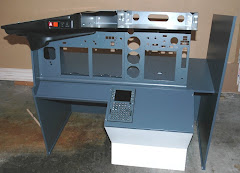Why the failure?
Bottom line, I tried to do it on the cheap. I thought that some of the off the shelf hardware was good enough, even if it didn't meet the look and feel criteria I specified in my brief. Looking at other cockpit builders, I felt that Robert Vandenberghe's set up was the way to go.
It met some of my criteria, captain's side only, controls in the correct position etc. He also has made extensive use of one of the more reasonably priced hardware vendors, Go Flight Inc.for his autopilot, throttle quadrant, radios etc. So I set off on the same path. What I really like about most of the Go Flight product range, they plug directly into any available USB port on your computer - no esoteric interface or soldering required.
Before we get too far into the hardware side of things, let's do a brief recap of the software being used and why.
Microsoft Flight Simulator (version 10. AKA FSX)
- Why? Most commonly used flight sim. A lot of add ons are available from other vendors to heighten the flight experience
- I use it primarily for external views (more on this topic in future posts)
- Comes with a number of different aircraft, I'm interested in mastering the Boeing 737 (at a recent dinner, a real life general aviation pilot asked me why I was simulating a 737 and not a plane I may actually get to fly one day, like a Cessna 172. Simple answer - the 172 looks boring, not enough systems to master. So if I'm going to simulate something more complicated, may as well aim for something I'll never in reality get a chance to fly)
- However, the 737 that comes out of the box with FSX is primitive so I then added:
Wilco/Feel There 737 Pilot in Command (AKA PIC737 for the purpose of this blog)
- Excellent add on to FSX
- Has a more realistic flight planner than that provided out of the box with FSX
- Has SIDs and STARs (departure and arrival plates for most major airports)
- All autopilot functions are supported
- Comes with real world airline paint jobs
- Taught me a lot about the skills required to "fly" a 737
- Bottom line, a quality product - very happy with it
- Organizer for SIDs, STARs, airport layout and en-route charts
- Since these are constantly being updates, Navigraph provides a service where you can download what you need, when you need it
- Also have some training/tutorial videos so you can learn more about flying a STAR or a hold etc.
- A quality product and service, worth the money
So back to the hardware. I already have the yoke and pedal set from CH Products. Sorry but a joystick isn't going to cut it. You must master coordinated turns with yoke and pedal to have any chance of a realistic experience. At some point I'll upgrade to something more in keeping with the real look criteria (this for example) but for now CH is just fine.
Trying to recreate Robert's cockpit, my next purchase was the autopilot controller from Go Flight. Initially very happy with the product. It improved the flying experience immensely. No more mucking around clicking the mouse on the auto pilot controls in PIC737! One annoying aspect though, the unit would occasionally lock up mid flight. Returned it to Go Flight and they upgraded the firmware and sent it back to me. Worked ok for a while, then started playing up again. I lived with this for a while but honestly, I think it was the start of me thinking "maybe I should go large on this and try to get something better quality / less frustrating". We'll revisit this later.
Radios. You're forever re-tuning them. Not having to click on the fussy little dials in FSX is a godsend. No wonder they "invented" auto tune radios in FSX. Real pilots need to tune the radios and so shall we. Again I opted for some Go Flight units. In my mind, these are the best products from Go Flight. They have always worked flawlessly and are a joy to use. Worked with any FSX aircraft or add on I've thrown at them. Only downside - they aren't the exact size of real 737 radios...
Next, the EFIS from Go Flight. It mainly controls what you see on the navigation display in the 737 cockpit. You'll find that you will be fiddling with this all the time in PIC737, to alter the range displayed etc. Getting a piece of hardware to do this again increases the realism. At the time I bought this unit though, Go Flight didn't have a driver that worked with PIC737...
This is where things started to go really pear shaped. The frustration in getting all of the parts to work together will drive you nuts. It did with me. What it did do though was force me into doing more research, before laying out cash on more hardware. You can read more about it here if you like.
In my research I found others who have been down this path before. I'll talk more about them in the next post.






No comments:
Post a Comment